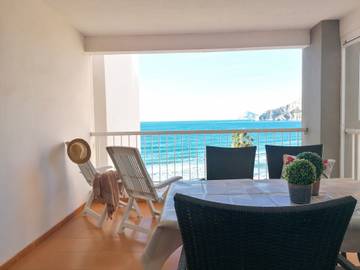
Apartments on the Costa Blanca
Find suitable accommodation
- Holiday rentals
- Spain
- Valencia Region
- Alicante Province
- Costa Blanca
- Apartments on the Costa Blanca
























Most popular holiday regions in Mallorca on the Costa Blanca
Property types and holiday ideas on the Costa Blanca
Apartments on the Costa Blanca
City and coastal apartment stays
Apartments across the Costa Blanca provide flexible accommodation options in both vibrant cities and quieter coastal towns. Urban properties in Alicante's historic neighbourhoods like Santa Cruz and El Barrio place visitors within walking distance of museums, the impressive Castillo de Santa Bárbara, and the bustling Mercado Central where local vendors sell fresh produce and handmade goods.
Coastal apartments in resorts such as Benidorm offer proximity to beach promenades, entertainment venues, and the full range of urban amenities. These properties typically include modern kitchens, balconies or terraces, and air conditioning, making them ideal for self-catering holidays where guests can shop at local markets and prepare meals using regional ingredients.
Charming locations across the region
The whitewashed old town of Altea provides a picturesque setting for apartment stays, with narrow cobbled streets leading to a hilltop church offering sweeping coastal views. Properties here combine traditional architecture with modern comforts, situated near the seafront promenade and artistic quarter filled with galleries and craft shops.
Torrevieja's apartment options include properties near the salt lakes, which create striking pink-hued landscapes, and Mar Azul area developments with communal pools and gardens. The town's position along the Mediterranean provides easy access to multiple beaches, whilst the indoor Mercado de Abastos offers an authentic Spanish market experience throughout the year.
Cultural experiences and local life
Festivals and traditional celebrations
The Moors and Christians festival takes place across numerous Costa Blanca towns, with elaborate parades featuring participants in medieval costumes recreating historical battles. These celebrations typically occur between spring and autumn, with each town holding festivities on different dates commemorating their own liberation from Moorish rule centuries ago.
Alicante's midsummer Hogueras de San Juan festival transforms the city with massive sculptural installations later set ablaze, accompanied by fireworks displays and beach parties. Throughout the region, local fiestas celebrate patron saints with processions, traditional music, and communal meals where neighbours share paella cooked in giant pans.
Authentic dining and nightlife
Apartment stays allow visitors to experience local dining culture by shopping at traditional markets and discovering neighbourhood tapas bars frequented by residents rather than tourists. The Spanish custom of eating main meals during early afternoon provides opportunities to enjoy menú del día set lunches offering three courses at excellent value in family-run restaurants.
Evening paseos along coastal promenades and town squares reveal local social life, where families stroll and friends gather at terrace cafés. In cities like Alicante, the Barrio Antiguo neighbourhood near the cathedral comes alive after dark with lively bars serving vermouth and small plates, whilst Benidorm's Avenida Comunitat Valencia hosts clubs featuring international DJs during summer months.
Alicante's Explanada de España promenade features over 6 million marble tiles creating its distinctive wave pattern.
Making the most of apartment holidays
What experiences define the Costa Blanca?
- Shop at authentic Spanish markets
- Take the scenic tram along the coast
- Sample traditional Valencian cuisine
- Visit historic castles and fortresses
- Explore charming old town quarters
1. Shop at authentic Spanish markets
Weekly markets throughout the region offer fresh local produce, handcrafted items, and regional specialities at prices considerably lower than tourist-oriented shops. Alicante's Mercado Central operates daily in a striking early 20th-century building, where stallholders proudly display seasonal fruits, vegetables, locally caught fish, and artisan cheeses perfect for preparing meals in apartment kitchens.
2. Take the scenic tram along the coast
The narrow-gauge tram railway connects Alicante with Denia, stopping at coastal towns including Benidorm, Altea, and Calpe along its scenic route. Originally built for transporting quarry materials and fruit to ports, this historic line now provides an economical and relaxing way to explore the coastline whilst avoiding holiday traffic and parking challenges.
3. Sample traditional Valencian cuisine
Authentic Valencian paella originated in the Albufera wetlands near Valencia city, prepared with white rice, green vegetables, rabbit, chicken, and sometimes snails. Whilst tourist versions appear on coastal menus, seeking out restaurants in inland towns or asking locals for recommendations reveals establishments serving traditional recipes passed through generations, often featuring seasonal ingredients.
4. Visit historic castles and fortresses
Moorish and medieval fortifications dot the Costa Blanca landscape, many offering free or nominal admission. Denia's hilltop castle contains archaeological exhibits spanning Iberian, Roman, and Islamic periods, whilst Guadalest's dramatic mountain-top fortress provides stunning views over the surrounding valleys and reservoir below.
5. Explore charming old town quarters
Historic centres throughout the region feature whitewashed houses with blue-painted doors and window frames, narrow streets designed to provide shade during hot summers, and hidden courtyards revealing Moorish architectural influence. Altea's old town climbs a hillside crowned by its distinctive blue-domed church, whilst Villajoyosa displays colourful house facades along its seafront, painted in vibrant hues by fishermen to identify their homes from the sea.